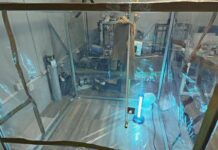
Instrumentation firm Vaisala writes
The Sigrid Jusélius mausoleum was built in 1901-03 and is a significant cultural site in Finland. With sandstone walls and interiors richly decorated with frescos, the mausoleum presents a major preservation challenge. The original frescos were destroyed in the early years by excess moisture, and were repainted later. The Jusélius Foundation, which owns and maintains the building, has recently invested in the latest technology to continuously monitor humidity and temperature to keep this exceptional building in good condition. This monitoring capability is growing in importance as climate change increases the frequency of precipitation.
The Sigrid Jusélius Mausoleum was commissioned by Fritz Arthur Jusélius, in memory of his daughter Sigrid Maria, who died of tuberculosis at the age of 11. Built in the neo-Gothic style, the octagonal building is adjoined on the east side by a small vestibule and on the west side by a semi-circular chancel. The vaults and walls in the central part are supported by buttresses and the high windows are topped by triangular pediments. The base was built of Finnish grey granite and the façade was made of yellow sandstone from local coastal areas.

Damaging environmental effects
In an unheated and unventilated building made of porous sandstone, the frescos started to decay almost immediately. Moisture penetrated the sandstone walls, dissolving the potassium nitrate in the mortar, and the water-soluble salts in the sandstone passed through the frescos and crystallized on the surface.
Ventilation ducts were constructed in 1916-17, but this was too late for the frescos, which were replaced in 1925 with bronze reliefs. Following the death of Fritz Jusélius in 1930, the Sigrid Jusélius Foundation assumed overall management of the building. Renovation and improvement works were conducted, but a fire started from heating stoves and the mausoleum suffered considerable damage.
The Foundation decided to restore the building; the façade was changed to Swedish sandstone; oil-fired central heating was installed, and the frescos were re-painted in the late 1930’s. The frescos have survived for over 80 years and the mausoleum has become a major attraction; opening for visitors in the summer.

Humidity and temperature
High numbers of visitors can increase humidity which may be absorbed by the porous sandstone walls, and concurrent cold temperatures may cause condensation on the surface of the frescos, resulting in run-off marks. The preservation of the sandstone structure and frescos therefore requires steady temperature and humidity levels.
Climate change is causing an increase in the frequency and severity of weather events. For example, heavy rain in August 2019 resulted in flood water entering the mausoleum. The seams of the facade sandstones were therefore renovated in 2020 to protect the structures and frescos. In addition to repairs, the Jusélius Foundation has invested in the latest monitoring technology to ensure that future generations will also be able to appreciate this remarkable building. In 2020, the condition monitoring equipment was changed from traditional thermohygrometers to Vaisala’s viewLinc continuous condition monitoring system.
Monitoring conditions 24/7
The change is a significant step forward. The thermohygrometers measured heat and humidity, and printed graphs for the local parish personnel to follow up – unless it ran out of paper. The viewLinc system continuously monitors conditions all day, every day. Consequently, the conservator, Foundation staff and the maintenance team are able to access accurate information about conditions in the mausoleum remotely using a PC, tablet or smartphone – from anywhere, and at any time.
Intuitive and simple to operate, the viewLinc software runs on a server, gathering readings from dataloggers installed in the mausoleum. With a secure login, users are able to access the software via the internet, but it is also possible to configure the system to automatically issue reports at, say, daily, weekly or monthly intervals.
In addition to the provision of recorded and live data, the system can also issue alerts if the monitored conditions reach pre-determined levels. This facilitates immediate changes to the heating and air conditioning settings in response, for example, to the effects of intense rainfall.

The monitoring systems generates a comprehensive database which can be correlated with visitor footfall and weather conditions to create a better understanding of the ways in which these variable factors affect the internal conditions of the mausoleum. As a result, it will be possible to decide whether visitor numbers should be restricted during rainy periods – an issue that may become more important if summer rainfall in Finland continues to increase.
The viewLinc monitoring system is wireless; a particularly important feature for historic buildings, because installation does not require the drilling of holes or the installation of unsightly wiring.
There are two Vaisala RFL 100 data loggers in the mausoleum, one on each floor. The loggers continuously gather temperature and humidity data, and transmit it to the VaiNet AP10 access point. These discreet devices were hung on hooks that were already located on the walls. Data are transferred via a computer in the nearby chapel, to the Vaisala datacloud service. Further loggers can be quickly and easily added to the system, which means that it is flexible and future-proof.






